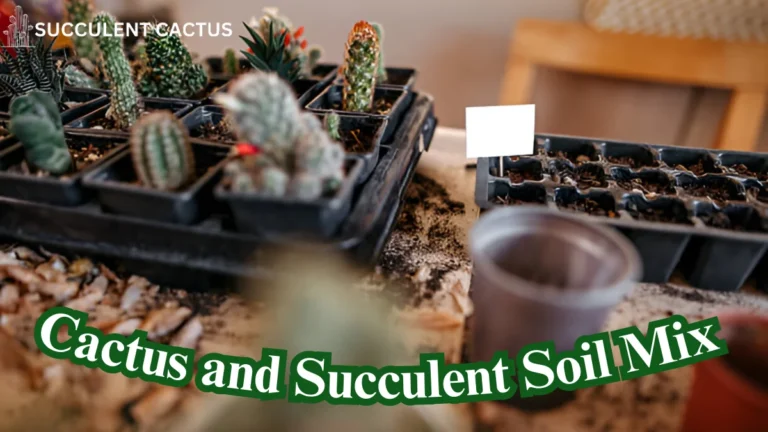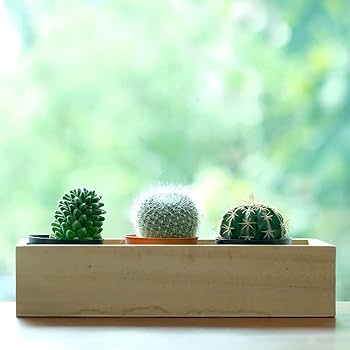How to Revive a Succulent Cactus: Expert Guide for Plant Lovers

Succulent cacti are a popular choice for indoor and outdoor gardening due to their unique, resilient nature. Known for thriving in harsh conditions, cacti are relatively low-maintenance plants that can add color and texture to any space. However, even the hardiest succulents can face health challenges, such as wilting, yellowing, or discoloration. Reviving a succulent cactus that seems to be on the decline requires an understanding of what went wrong and the steps to restore it to its full glory. This comprehensive guide will walk you through how to revive a succulent cactus, ensuring it thrives once again.
Understanding Why Your Succulent Cactus is Dying
Overwatering Issues
One of the most common reasons a succulent cactus may be struggling is overwatering. While cacti are drought-resistant plants, they still require a careful balance of moisture. If the soil is too wet, it can lead to root rot, which is often fatal. Signs of overwatering include yellowing leaves, soft stems, and a soggy or foul-smelling base.
Lack of Sunlight
Sunlight is crucial for succulents, and without adequate exposure, your cactus may not thrive. Succulent cacti need at least four to six hours of sunlight per day. If your cactus is too shaded, it will weaken and exhibit signs like leggy growth or faded colors.
Poor Soil Conditions
Cacti require well-draining soil to thrive. If the soil is too compact, it can trap moisture around the roots, leading to root rot. Similarly, soil that doesn’t allow air circulation will suffocate the plant’s roots. If your cactus is planted in such soil, it’s vital to replace it with a mix designed for cacti and succulents.
Signs That Your Succulent Cactus Needs Reviving
Yellowing and Softening of Stems
One of the first signs of trouble in a succulent cactus is yellowing or softening stems. How to Revive a Succulent Cactus starts with identifying the cause—often overwatering, insufficient sunlight, or nutrient deficiency—before it leads to further deterioration.
Wilting or Shriveling
Wilting or shriveling is another sign that your cactus is in distress. This typically happens when the plant is under-watered, or if the roots are struggling to absorb moisture from the soil. It can also occur if the cactus has been stressed due to a sudden change in environment or improper watering habits.
Brown Spots and Rotting
If you notice brown spots or rotting sections on your cactus, it’s a clear indication that the plant is suffering. Fungal or bacterial infections, which often stem from overwatering or excessive humidity, can cause rot. It is crucial to act quickly and remove any rotting sections to prevent further damage.
Assessing the Health of Your Succulent Cactus
Examine the Soil
The health of your cactus is largely determined by the condition of the soil. Start by checking the moisture level in the soil. If it’s too wet, it could indicate overwatering, which could lead to root rot. If it’s too dry, the cactus might be suffering from dehydration, and you will need to adjust your watering schedule.
Look for Pests
Pests, such as mealybugs, aphids, or spider mites, can also affect the health of your succulent cactus. These pests feed on the plant’s sap and cause stress, leading to wilting and discoloration. Check the cactus for any visible pests and treat it with an insecticidal soap if necessary.
Inspect the Roots
If your cactus is suffering from symptoms like wilting, yellowing, or browning, you should inspect its roots. Gently remove the cactus from its pot and check for any signs of rot or damage. Healthy roots should be firm and white or light tan. If the roots are brown, mushy, or smell foul, they likely have root rot, which needs to be addressed.
How to Revive a Succulent Cactus
Step 1: Remove the Plant from Its Pot
To begin the revival process, gently remove the cactus from its pot. Be careful not to damage the plant or its roots. Use a clean, sharp tool to lift the cactus out of the soil, avoiding unnecessary pressure on the stems.
Step 2: Inspect and Trim the Roots
Examine the roots closely. Cut off any damaged or rotting roots with a sterilized pair of scissors or pruning shears. It’s important to remove all affected roots to prevent the spread of rot. If there’s significant root damage, you may need to trim the cactus back as well, but don’t remove too much of the plant.
Step 3: Allow the Cactus to Callous
After trimming the roots or any rotting sections, place the cactus in a dry, warm location for a few days to allow the cut surfaces to callous over. This is a crucial step in the process, as it prevents further infections and helps the plant heal properly.
Step 4: Repot the Cactus
Once the cactus has calloused, it’s time to repot it into fresh, well-draining soil. Use a pot that has proper drainage holes to ensure water doesn’t accumulate at the bottom. Make sure the soil is loose and aerated, and avoid overwatering at this stage. Gently place the cactus in its new pot, ensuring the roots are spread out comfortably.
Providing Proper Watering After Revival
Understanding the Right Amount of Water
After you Revive a Succulent Cactus, it’s crucial to provide the right amount of water. Overwatering or underwatering can further stress the plant, so allow the soil to dry out completely between waterings. During the growing season, water every 2-3 weeks, but reduce watering significantly in winter.
How to Water Properly
To properly water your cactus, pour water into the soil until it starts to drain out from the bottom. This ensures the roots receive adequate moisture without becoming waterlogged. Avoid letting the cactus sit in standing water, as this can cause root rot.
Recognizing Signs of Overwatering or Underwatering
- Overwatering: If your cactus turns yellow or becomes mushy, you may be overwatering it. This can also cause the roots to rot.
- Underwatering: If the cactus appears shriveled or the spines are becoming dry, it could indicate that the plant is dehydrated.
How to Provide the Right Light Conditions
The Importance of Sunlight
Light is essential for the health of your succulent cactus. If your cactus has been struggling, it may be because it hasn’t been getting enough sunlight. Succulent cacti need bright, indirect light to thrive, so make sure to place it in a sunny spot.
Adjusting Light Exposure
If your cactus has been in low light, it may need to be gradually adjusted to higher light levels to avoid sunburn. Start by placing the cactus in a location with indirect light for a few hours a day, and gradually increase the exposure to full sunlight.
Using Grow Lights
If natural sunlight is limited, consider using grow lights. These lights mimic the sun’s rays and can help your cactus stay healthy. Place the cactus under the grow light for about 10-12 hours a day.
Rebuilding the Soil for Your Succulent Cactus
Choosing the Right Soil Mix
A well-draining soil mix is critical for the health of a cactus. You can create your own cactus soil mix by combining equal parts of cactus soil, sand, and perlite. This will ensure proper aeration and drainage for the roots. Avoid using regular potting soil, as it can retain too much moisture, which could lead to root rot.
Repotting After Revival
If the cactus was originally in poor soil, it’s essential to replace it with fresh, well-draining soil. This step will ensure the plant has a healthy environment in which to recover. When repotting, make sure the new soil is sterile and free from any pests or diseases.
Avoid Overloading on Fertilizers
While fertilizers are important for boosting plant growth, avoid fertilizing immediately after repotting your cactus. The cactus needs time to settle into its new environment and focus on recovery, so it’s best to wait a few months before fertilizing.
Maintaining Healthy Temperature and Humidity
Ideal Temperature Range
Cacti thrive in warm, dry conditions. To help your cactus recover, maintain a temperature range between 70°F and 90°F (21°C to 32°C) during the growing season. Avoid placing your cactus in locations where the temperature fluctuates rapidly, such as near windows with drafts or air conditioning vents.
Managing Humidity Levels
As desert plants, cacti prefer low humidity levels. High humidity can contribute to mold and rot. Ensure that your cactus is in an area with good airflow and dry conditions. If you live in a particularly humid area, consider using a dehumidifier to maintain an optimal environment.
Protecting from Extreme Cold
Avoid exposing your cactus to temperatures below 50°F (10°C) as this can cause cold stress. Cold temperatures can cause the cactus to stop growing or even kill it, so always protect it from frost or drafts.
Preventing Future Issues with Your Succulent Cactus
Regular Monitoring and Care
Preventing future problems with your cactus requires regular monitoring. Check the soil moisture regularly and ensure that your cactus is getting the right amount of light and water. Early detection of any issues will help you take corrective action before the plant becomes too stressed.
Seasonal Adjustments
Cacti undergo changes in their needs throughout the year. During the growing season, they require more water and light, while in the dormant season, they need less. Adjust your care routine according to the season to ensure the plant thrives year-round.
Proper Container and Drainage
Ensure that the container you use has proper drainage to prevent water from accumulating at the bottom. If the pot is too large, it may take longer for the soil to dry out between waterings, which could lead to root rot.
Common Myths About Reviving Succulent Cacti
Myth 1: You Can Always Save a Dying Cactus
How to Revive a Succulent Cactus depends on the severity of the damage, but in cases of severe root rot or fungal infections, recovery may be impossible. However, trying proper revival methods can give your cactus the best chance of survival.
Myth 2: Cacti Don’t Need Any Watering
Many people mistakenly believe that cacti require no watering at all due to their drought-tolerant nature. While it’s true that cacti are well adapted to arid environments, they still need some water, especially during the growing season. Overwatering or underwatering can lead to health issues. The key is to maintain a careful watering schedule that takes into account the specific needs of your cactus.
Myth 3: Cacti Can Survive in Total Darkness
While cacti are hardy plants, they still need light to thrive. Some varieties may tolerate partial shade, but they cannot survive in total darkness. Without adequate sunlight, a cactus will become leggy, lose its vibrant color, and may eventually die. Make sure to place your cactus in a location with plenty of indirect sunlight to ensure its health.
Frequently Asked Questions (FAQs)
1. How often should I water my cactus? The frequency of watering depends on the season and environmental conditions. During the growing season (spring and summer), water your cactus once every 2-3 weeks, allowing the soil to dry out completely between waterings. In winter, reduce watering to once every 4-6 weeks, as the cactus is dormant.
2. Can I revive a cactus with root rot? Yes, if you catch root rot early, it’s possible to revive your succulent cactus. Trim off any rotting or damaged roots, allow the plant to callous, and repot it in fresh, well-draining soil. Be sure to avoid overwatering after repotting.
3. What should I do if my cactus turns yellow? Yellowing is often a sign of overwatering, though it can also indicate a lack of sunlight or nutrient deficiency. Check the soil for excessive moisture and ensure the cactus is getting enough light. If the yellowing persists, trim off the affected areas and consider adjusting your care routine.
4. Can a cactus survive if it has been overwatered? A cactus can survive overwatering if caught in time. If you notice signs of overwatering, remove the plant from its pot, trim any rotting roots, allow it to dry out for a few days, and repot it in fresh, well-draining soil. Be cautious with watering going forward.
5. How do I know if my cactus is getting enough sunlight? Cacti need bright, indirect light for at least 4-6 hours a day. If your cactus is getting too little light, it may become leggy, with weak growth and faded colors. If this happens, move your cactus to a sunnier spot or use artificial grow lights to supplement its light needs.
Conclusion
To Revive a Succulent Cactus, you need patience, proper care, and attention to detail. Whether it’s struggling due to overwatering, underwatering, poor light, or pests, identifying the issue and taking the right steps can help it recover. With the right soil, watering, and sunlight, your cactus can regain its health and thrive. Prevention is key, so maintain a regular care routine and watch for early signs of trouble to keep your succulent cactus healthy for years to come.






